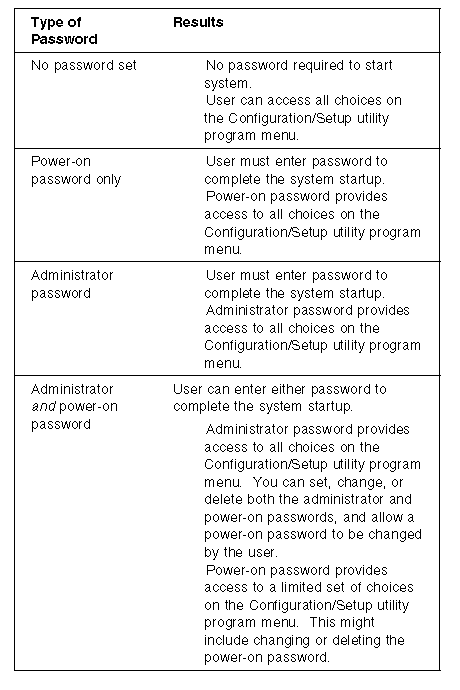

|
57.785 bytes |
Service Hints & Tips |
Document ID: MCGN-3QHQYM |
|
This document is provided to IBM and our Business Partners to help sell and/or service IBM products. It is not to be distributed beyond that audience or used for any other purpose. |
PCServer330 - Resolving configuration conflicts, System security
Applicable to: World-Wide
Resolving Configuration Conflicts
The resources used by the server consist of IRQs, DMA, I/O port addresses, and memory. This information is useful when a resource configuration conflict occurs.
Conflicts in the configuration occur if:
A device is installed that requires the same resource as another device. (For example, a conflict occurs when two adapters try to write to the same address space.)
A device resource is changed (for example, changing jumper settings).
A device function is changed (for example, assigning COM1 to two serial ports).
A software program is installed that requires the same resource as a hardware device
The steps required to resolve a configuration error are determined by the number and variety of hardware devices and software programs installed. If a hardware configuration error is detected, a configuration error message appears after the server completes POST and before the operating system is loaded. You can bypass the error by pressing Esc while the error message is displayed.
The Configuration/Setup utility program configures the system hardware and PCI interrupt requests. The program does not consider the requirements of the operating system or the application programs. See Resolving Software Configuration Conflicts on page 66 for additional information.
Resolving Hardware Configuration Conflicts: Use the following information to help resolve hardware configuration conflicts:
1. Run the Configuration/Setup utility program to view and change resources used by the system board functions and the PCI interrupt requests (IRQs), if necessary. Record the current settings before making any changes. (See Starting the Configuration/Setup Utility Program on page 58 for instructions.)
2. Determine which adapter or device is causing the error.
3. Change configuration resource allocations. Use the Configuration/Setup utility program to view or change system board resource allocations. Jumpers and switches define the system resources a device uses. If the settings are incorrect or set to use a resource that cannot be shared, a conflict occurs and the device will remain deactivated by the configuration program.
4. Change system board jumpers or switches.
5. Remove the device or adapter. Some configurations are not supported.
Resolving Software Configuration Conflicts: The memory-address space and IRQs used by some hardware options might conflict with addresses defined for use through application programs or the EMS. (EMS is used only with DOS.)
If a conflict exists, one or more of the following conditions might exist:
The system cannot load the operating system.
The system does not work.
An application program does not operate, or it returns an error.
Screen messages indicate a conflict exists.
To resolve conflicts, you can change the software or hardware configuration.
|
Note |
The best way to resolve memory-address conflicts is to change the addresses used by the application program or the device driver. You can use the Configuration/Setup utility program to change addresses.
If a device driver is causing a memory-address conflict, refer to the operating-system documentation or the documentation supplied with the device drivers.
System Security
To control access to the server, security features, such as adding passwords, securing diskette access, and defining a system owner's name that displays during startup can be implement
To set, change, or delete a password:
1. Select System Security.
2. Select the password that you want to change.
The System Security choice appears only on the full Configuration/Setup menu.
After a power-on or administrator password is set, you must enter the password when you power-on the server.
(The passwords do not appear on the screen as you type them.)

|
Search Keywords |
| |
|
Hint Category |
Hardware Maintenance Information | |
|
Date Created |
07-01-98 | |
|
Last Updated |
04-06-98 | |
|
Revision Date |
03-06-99 | |
|
Brand |
IBM PC Server | |
|
Product Family |
PC Server 330 | |
|
Machine Type |
8640 | |
|
Model |
11Y; 21Y; PB0; PM0; PT0 | |
|
TypeModel |
| |
|
Retain Tip (if applicable) |
| |
|
Reverse Doclinks |